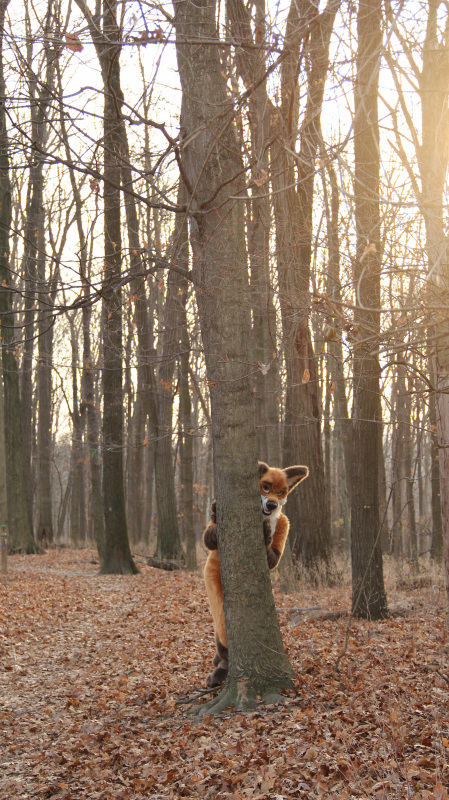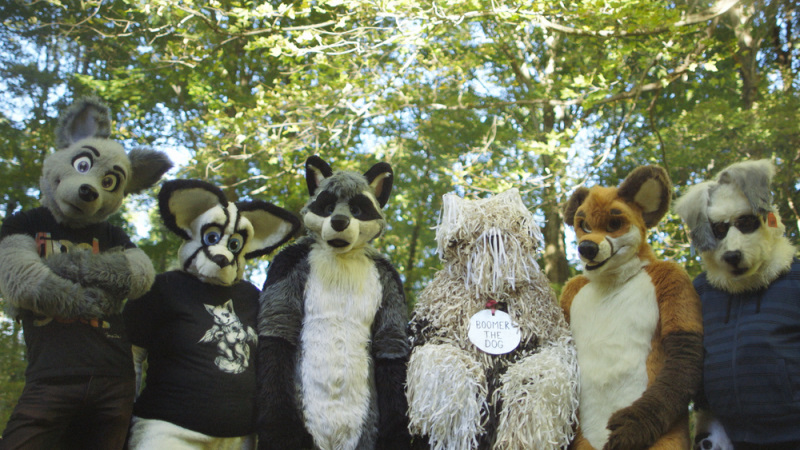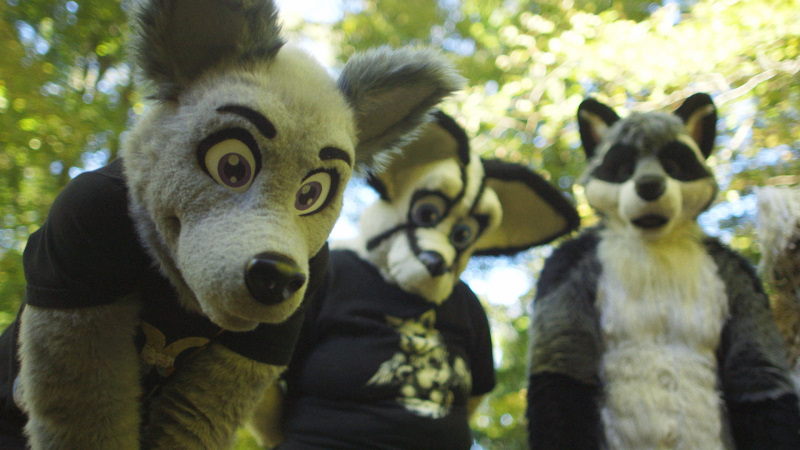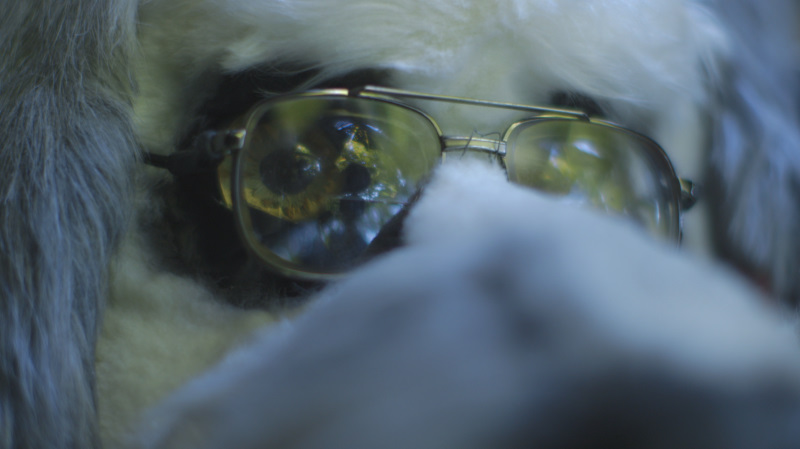Like many first time documentarians, Dominic Rodriguez decided to pick a subject close to home. In his case, it was the sub-culture of furries for his debut feature Fursonas. A furry himself, his portrayal isn’t exactly warts-and-all, but it’s more nuanced than either the PR pieces that the scene can produce, or the prurient and exploitative ‘reporting’ that comes from the cavalcade of daytime talkshows. His film may not endear him to everyone in furrydom (especially its self-appointed “storyteller,” Uncle Kage), but it’s lovingly critical of the anthro-scene.
(A version of this story first appeared at www.austinchronicle.com.)
Richard Whittaker: It always seems like there’s a group that it’s ‘OK’ for popular culture to be dismissive of or be mean about. It used to be LARPers, then it was Bronies, now it’s furries. Why do you think that it’s this group at the moment?
Dominic Rodriguez: I don’t know. I just think about when I started it. I didn’t know a single furry, I didn’t know any fur suiters, and all I saw was just this image of all these hundreds of people in costume. You don’t know who they are. They’re just furries. And because you don’t know who they are, they’re easier to judge. That’s why I thought it was so important in the documentary that it took its time, and you got to feel who these people were in the first half, so it’s not as OK to judge. So when it does happen, it’s not OK. How could anyone judge Boomer? How horrible. But then, of course you judge Boomer. Look at the first scene in which you see him – he looks like a crazy person. But all it takes is getting to know people and accept them.
RW: Why did you decide to make the documentary in the first place?
DR: I guess there are two answer to that question. One is because I needed to have a senior thesis film.
RW: That’s as good a reason for making any film as any.
DR: Yeah, so basically we had to make a 12 minute film for my Production IV class when I was a senior in film school. We had one idea that kind of fell through, and we were scrambling to get something else. This was during the Summer, and Anthrocon was going on. Anthrocon is the biggest furry convention in the world, so I took my crew there and went, hey, maybe this can be something interesting.
The other way to look at this is that I’ve been a furry for a long time. I’ve been interested in this stuff since I was maybe 12 years old, and I’d been looking at it from a distance: not necessarily wanting to identify myself with it, but just seeing how the community was treated by the media, and then seeing how the community responded to that, I felt that nobody was quite doing it justice. So I always wanted somebody to make a documentary about it. For a long time I didn’t want it to be me, because I didn’t want to touch this stuff with a 10 foot pole. Now I’m glad I dove into it. So it was convenience, and then it was sort of meant to be, because it was just following me throughout my life.
RW: There’s a whole bunch of documentaries where the filmmakers are trying to explore a topic where there’s automatically, not mockery, but eyebrows raised. The My Little Pony documentary, for example, about the Bronies …
DR: There are two My Little Pony documentaries. That thing got so much press.
RW: So knowing that, as you point out, furries are the ultimate Maurie Povitch ‘bring them out for the yokels to throw stones at’ guests, did that put extra pressure on you?
DR: Definitely a lot of pressure, but it was also freeing, in a weird way, because I knew that I wanted to make a serious documentary, and I knew that my crew was serious about it, and we knew that we weren’t going to do something that was an easy, mocking kind of thing. We wanted to do something that was complicated and with layers to it. The cool thing about that is that it gave us freedom. When we had this idea for another documentary before the furries, the one that fell through, it was about autism and the children’s hospitals. Thinking about how that would have went, there’s really only one direction you could have taken that, and you have to treat it very seriously. With this, it’s OK to be funny, and it’s OK to laugh with them, and have a little bit of silliness, but also endear people to them. The fact that I felt that nobody had done it right was great, because I felt that nobody had done it right.
RW: So with documentaries covering the scene before, what do you think they’d done right and wrong?
DR: There’re two ways that I felt that it had been done. There’s the very exploitative, mocking view of furries, and then there are documentaries or short projects, usually done by furries themselves, that are PR pieces and defensive, even. ‘We aren’t what you think, we give to charity, we’re a great group of people who make the world a better place and we make people smile. You should be proud to have us in your lives.’ Both sides felt phony to be, and it felt like everybody’s right, and everybody’s wrong. I wanted to do a film about people and their complexities.
That was the question furries would always ask me, is this a positive or a negative documentary, and I would always reply, that’s a ridiculous question, because it’s not meant to be one or the other. It’s meant to be real.
RW: How did you pick the people you wanted to concentrate on, so you could balance the core versus the outliers?
DR: First it was just a matter of finding people who would even talk to me. A lot of furries are understandably very skeptical of media, and are shy, and don’t necessarily want to spend four years talking to someone when they don’t know how the film’s going to end up. So I started out just emailing hundreds of known fur suiters. There are data bases online of, these are people who have costumes and blah blah blah. I knew I wanted some diversity, but I didn’t go crazy. I went, who is close to me, who has a costume that I enjoy looking at, and who is responding to my emails?
Usually, my rule is, if they’ll talk to me, and I can get there, then I will do an interview. There may be about seven or eight interviews we threw out of people that didn’t make the cut. It was almost – random isn’t the right word, but I didn’t know who it was going to be. Then there are people that I purposefully sought out in the second half that I needed to fill out the story. People like Chew Fox and Uncle Kage, and Varka, the guy who makes the dragon dildos. These are important figures that, in order to tell the story I wanted to tell, I had to seek them out specifically.
And then Boomer is great, because Boomer is so central to the story. Boomer was also completely of convenience, because Boomer is 20 minutes from my house. It’s not like I travelled to the other side of the world specifically for him, because I didn’t know if he was somebody that I wanted in this or not. But he turned out to be really interesting.
RW: The tension between him and Kage is fascinating and if anyone is going to come into this as, ‘this is a culture I don’t understand,’ Kage comes across as the strangest character of all. He’s also clearly not happy at you.
DR: You’re right, he does not like me.
 RW: So how did you get any footage of him, considering he is so forthright about how he wants there to be a very specific representation of the community, and to create an idea of a community, and a very specific idea of how the scene is portrayed?
RW: So how did you get any footage of him, considering he is so forthright about how he wants there to be a very specific representation of the community, and to create an idea of a community, and a very specific idea of how the scene is portrayed?
DR: For starters, it’s important to note that that footage of him talking, that stuff is all just for free on YouTube. He does a Furries in the media panel at convention around the world.
Sometimes officially, sometimes unofficially, people will film it and post it online. So he’s aware that stuff is out there, which is even more ludicrous to me. It’s not like we snuck in, it’s just there. I think he’s just been doing this for so long that he’s never really been challenged before, and it’s strange that this stuff exists.
As far as the relationship with me, the fandom for me is that I want to express myself and do what I want to do, and I feel the exact same way about filmmaking. I have to have control, I have to be able to say what I want to say. There’s a parallel there, and the fact that the Anthrocon policy is, if you film here, you have to show us the finished film, and if we can’t recommend changes, then you’re not allowed to show it to anybody, to me is ridiculous. It’s in no way what I wanted to do in the fandom or say as a filmmaker, and that authority is something I want to push up against. So I don’t know what is going to happen. I’m very excited and nervous. I think that was he has on his side is that he’s always gearing public opinion, but I think that a lot of people don’t take him seriously. I talk to more furries, and I’ve been pleasantly surprised that a lot of them are, finally, someone’s saying something. If they don’t like him they just ignore him, but no one has ever done anything like this. So it’s very exciting.
RW: One thing you do tackle is that a lot of furries are gay, and there’s been this discussion about what happens to gay culture as it becomes mainstream. But how much do you think that mainstream gay culture has permeated furry culture?
DR: It’s striking when you’re in the community how many people are on the LGBT spectrum. I actually think it’s funny, because I was actually listening to Kage talking about this yesterday, so I’ll actually paraphrase him. He was saying, is it that there’s something about furry fandom that attracts people who are gay, or that there’s this openness in the community, and that’s what you’re attracted to. Take media out of the equation: when you are at a furry convention, there’s just a collective understanding that you’re accepted for what you’re in to and what you are. That’s really refreshing to a lot of people, because they feel they can’t have that in real life. And then it gets more complicated when media’s involved, because you have to deal with people’s collective insecurities.
RW: When you have the figure that 80% of furries are men, and 80% of that 80% are gay …
DR: Everyone’s treating that as fact. But it’s said in such a throwaway kind of way. I think that’s roughly true, but he’s not a scientist. C’mon, it’s not exactly true.
RW: Yeah, it didn’t sound like anyone had done a poll. And since you have a lot of people who are constantly in suit, you’ve got no clue.
DR: It’s really interesting to meet a person and not know what they look like or anything about them. To feel like you know somebody, and then later realize when they take their head off, oh, shit, I didn’t know what they look like, I didn’t really know that much about them at all.
RW: How does that affect relationships, the balance between knowing them in-suit and out?
DR: It’s like a strange game of anonymity, especially when you’re in a suit and they’re in a suit. You’re putting on a face and you’re becoming something that isn’t you, but it’s also a way to get to the most pure you, and the most pure ‘this is who I am.’ There’s definitely something cool about that, and when you go into the fur suit lounge, which is the area that only fursuiters are allowed to go into – because when you take your head off in public it’s considered a bit of a taboo, like breaking the magic. But to me it doesn’t matter, because real life is magic, and in the documentary I take my head off all the time.
RW: I know a lot of people who work in haunted houses, and if you are in costume, you are always ‘on’ in public. Until you’re out of the scene, you are in character, and it’s verboten to break character.
DR: I think this is why some furries are skeptical that the film itself is breaking the magic. To have something that goes this far and asks questions that are this personal, or really asking why people do it, or asking who they are specifically, or asking more complicated things, that’s verboten. That’s why people don’t go into the media, because of the fear of persecution and not wanting people to ask those questions. When really I don’t think there’s much to be scared of. It’s just complicated, and that’s what people are.
RW: And then there’s the complicating factor that, when somebody does hit the media, it’s someone like Boomer, and Boomer is Boomer ….
DR: There isn’t anyone else like Boomer.
RW: Again, it’s this idea that there’s a scene or a community, but there’s a difference between diversity in a scene, and people who are lumped together because they have the same interest.
DR: Absolutely.
RW: So beyond the pop-up community of an event like Anrthrocon, is it really a community, or is it just people who have a shared interest?
DR: I agree that we’re putting that label on it, and not everybody here is connected. But having said that, I would call it a community, because there are people I have met who I never would have met otherwise. That’s the thing – if Boomer never went to the media, if Boomer never talked to anybody, and Boomer just went to conventions and he had his paper costume and he barked, everybody would love him, nobody would care. It’s completely fine until you go out to the media, and that was his transgression. I think it absolutely is a community in that sense, that you can make friends that you wouldn’t necessarily make in any our sphere.
RW: For you, what’s been the response so far, both in the making of it and now it’s getting a release? Because, as a furry making a documentary about furries, you’ve inevitably become a standard bearer, but it’s very pointedly not a PR piece.
DR: I think it’s a good thing that I’ve had to do this, because for years I’ve been expecting that I was the one expecting people to be open with me. It’s a response to the Kage attitude: why can’t you just tell me what’s real, and let people accept you for your complexities? But the fact that I now have to be in front of the camera and in front of the microphone, and I have to be the one that’s asked these questions, as though I was some authority about all furries, I completely understand where a lot of them are coming from. Because the fact that anything you say can and will be used to represent this entire community is very intimidating. But it’s good to have to turn the tables on me, and make me see it from their perspective as the last stage in this weird experiment that I walked into.
RW: But you are also on-screen in the film a lot, so what was the decision for you to be one of the characters in your own film, and having it be in part about the process of making the film, rather than just being a series of character studies?
DR: For a long time, I tried to stay out of it. I was literally thinking, ‘This isn’t about me, this isn’t my story, I need my distance to talk about this stuff.’ It required help from other people saying, OK, does this make sense? Because once I became part of it, it got a lot more confusing, with me having to ask myself questions that I didn’t even necessarily know the answer to.



